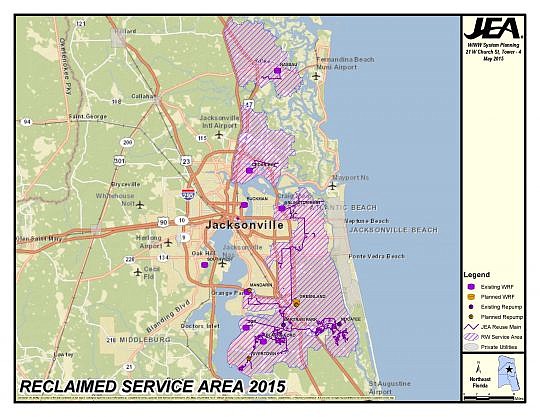
There’s only so much of it, so you’ve got to make the most of it.
When it comes to water, JEA takes that concept a step further.
“It’s using the right water for the right use,” said Rob Zammataro, water and wastewater system planning manager.
More than 107 million gallons of potable water (purified for drinking) are delivered each day to more than 330,000 commercial and residential customers.
The water is drawn from 137 artesian wells drilled deep into the Floridan aquifer.
It’s aerated to remove sulfur, disinfected in accordance with health standards and then tested for quality and safety at 37 treatment facilities before being delivered through 4,300 miles of pipes.
After the water is used and goes down the drain, about 82 million gallons of water and solids are collected through the sanitary sewer system and sent to 11 wastewater treatment plants.
That’s where the “right water for the right use” comes into play.
Most of the 25 million gallons that don’t make it back to the system are used for watering lawns and other landscape irrigation.
But you don’t really need to water your lawn with drinking water.
To reduce the amount of potable water used for sprinklers, JEA offers customers in certain parts of its service area the opportunity to connect to a source of reclaimed water.
The reclaimed water is delivered through a dedicated pipe system from treatment plants to homes and businesses. A network of purple pipe has been installed in the most recent major developments, such as Nocatee.
Customers who connect to reclaimed water have two meters to separate the charge for potable water from what’s used for irrigation.
Currently, more than 7,000 customers water their lawns — and even golf courses — with reclaimed water.
Zammataro said JEA is adding about 1,000 reclaimed water customers each year.
Before reclaimed water was available, all of the treated and tested wastewater was discharged into the St. Johns River, but by offering reclaimed water to customers, the discharge has been reduced by about 17 percent.
That’s about 13.5 million gallons a day that’s not going into the river — and about 13.5 million gallons of water that doesn’t have to be pumped out of the aquifer to meet potable water needs for irrigation.
“It works for the ratepayers and it works for the environment,” said Zammatoro.
St. Johns Riverkeeper Lisa Rinaman agreed.
Reclaimed water is an important part of the conservation strategy because it reduces the amount of nutrients that contribute to algae blooms.
Increasing the use of reclaimed water for irrigation reduces the amount of water that must be drawn from the aquifer and that also helps the river’s health, she said.
“It’s not a silver bullet, but it’s part of what needs to be done and it’s a good start,” Rinaman said.
@DRMaxDowntown
(904) 356-2466